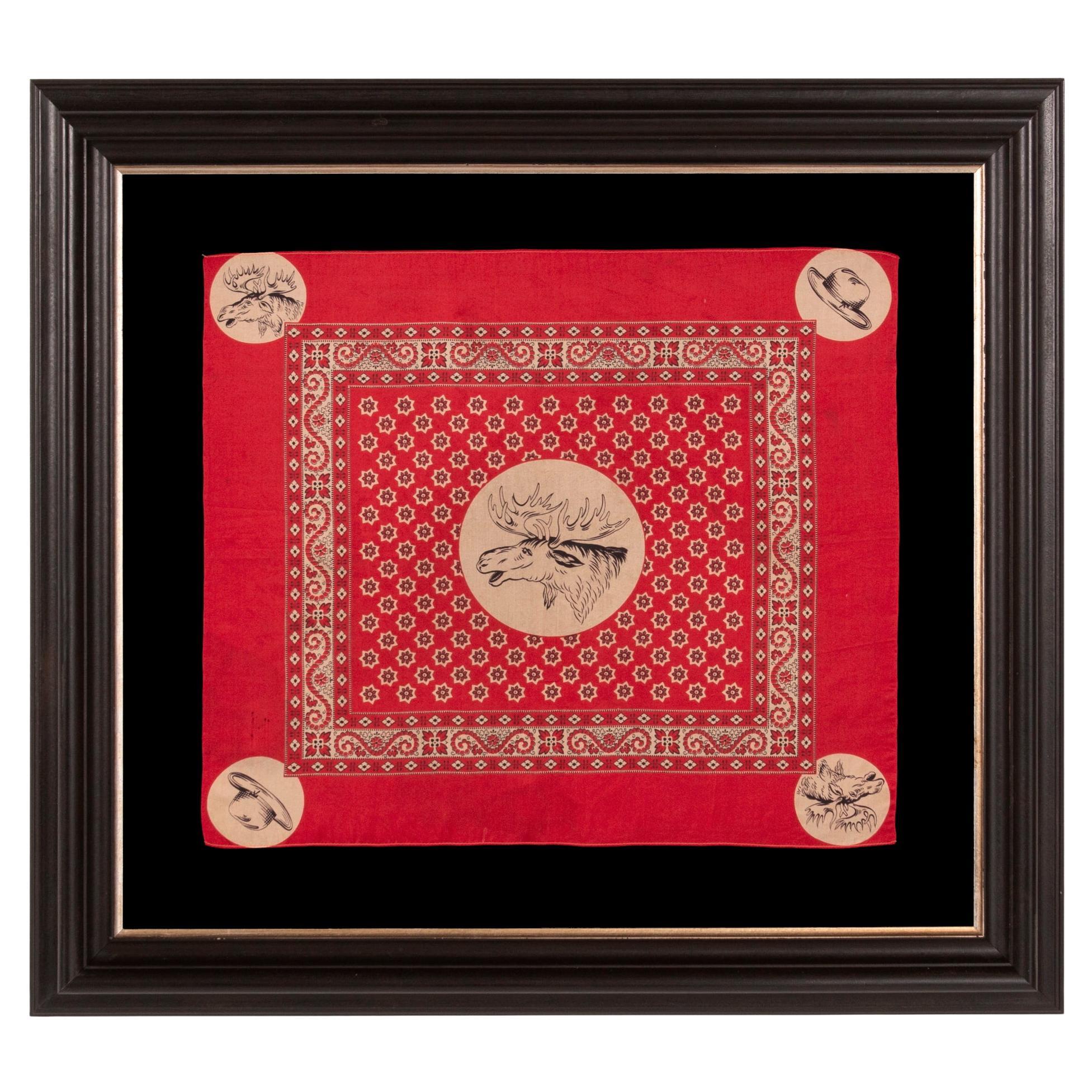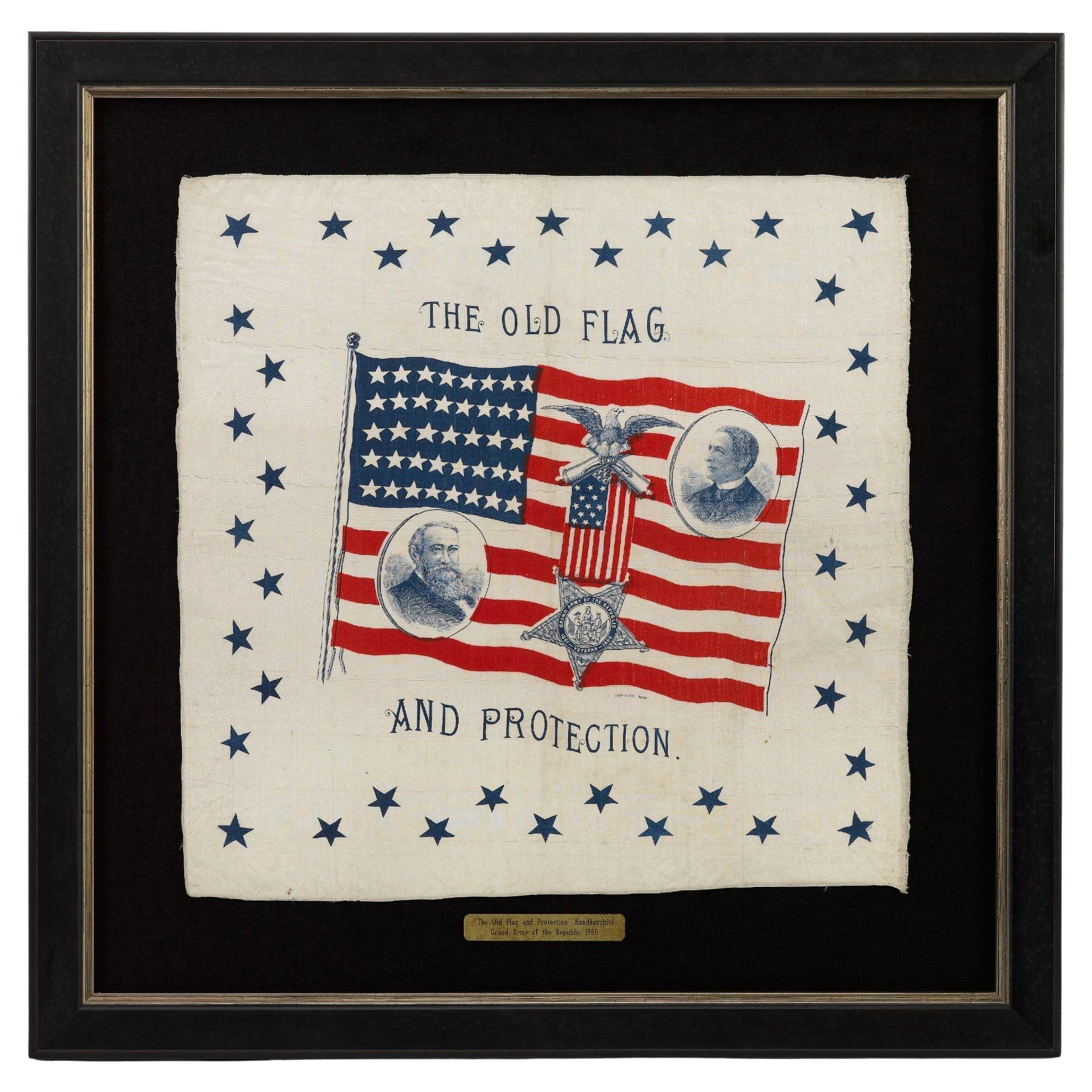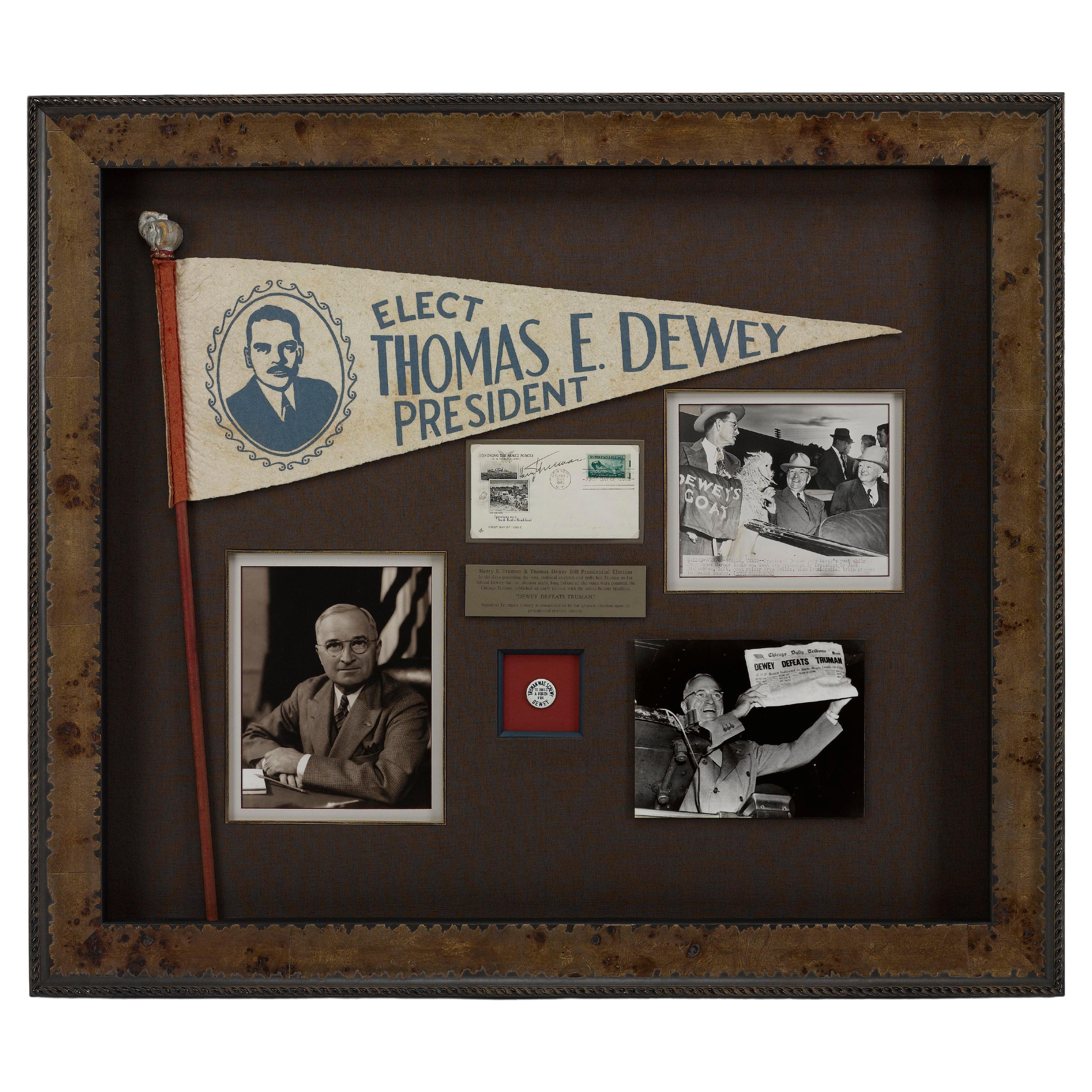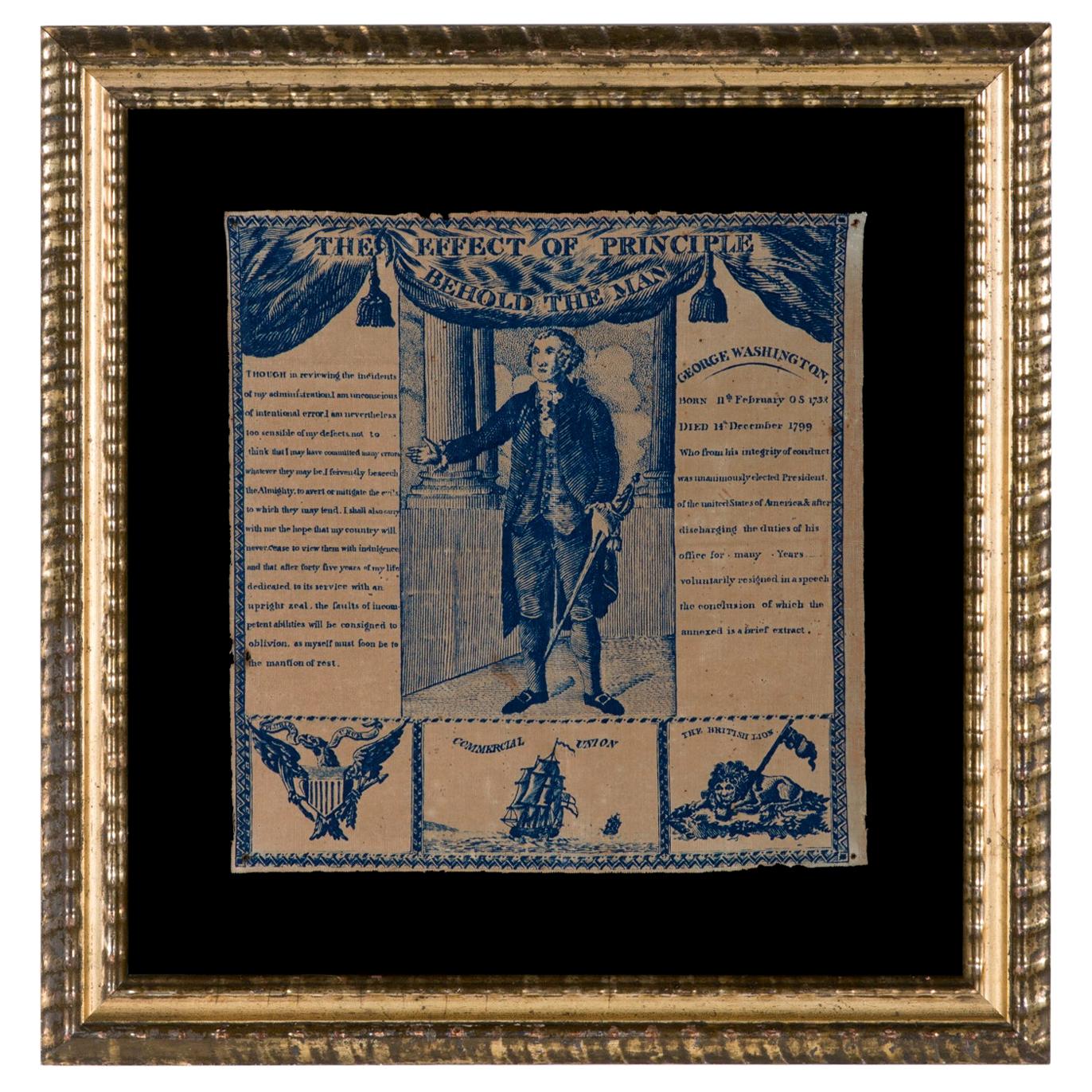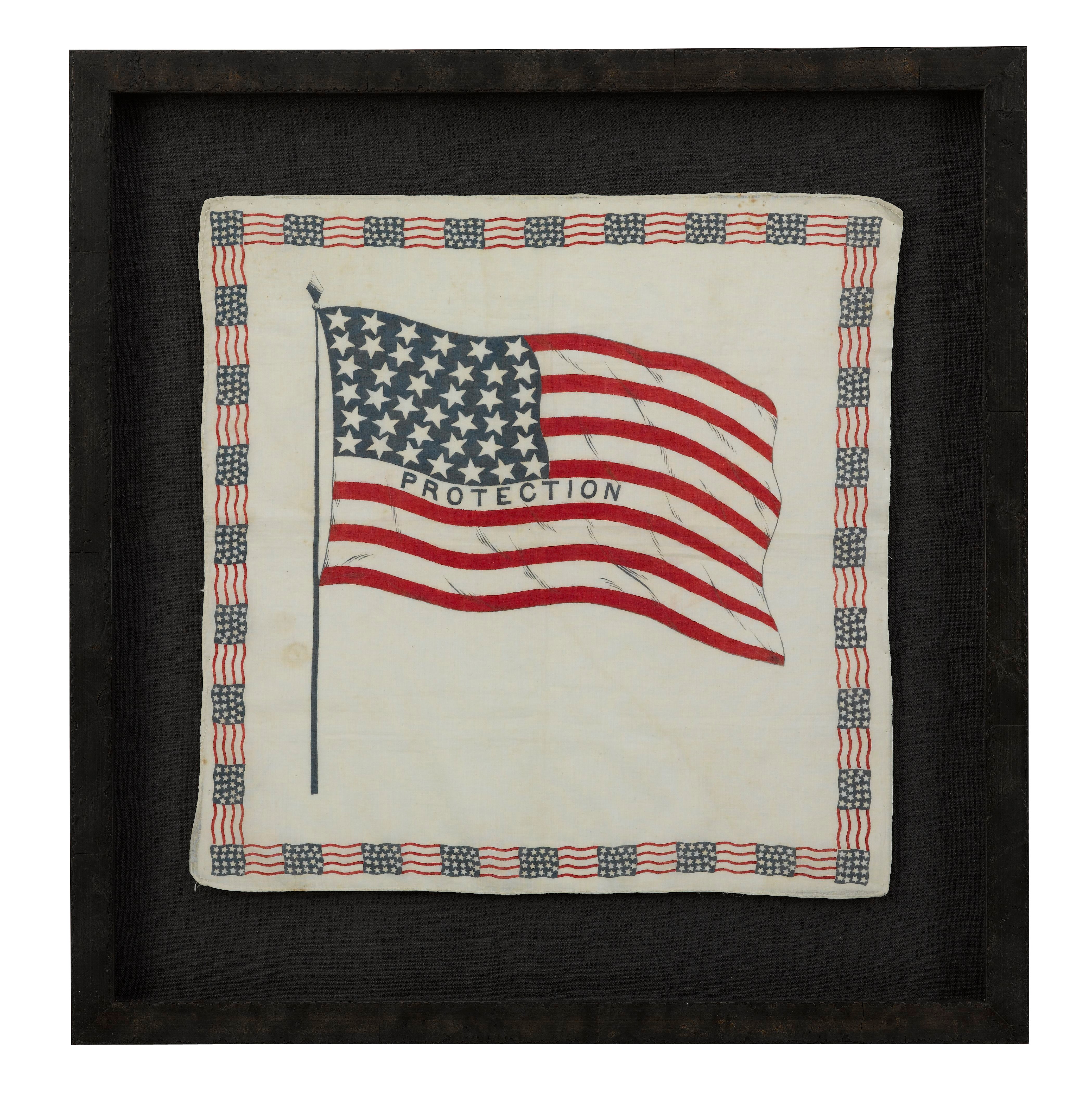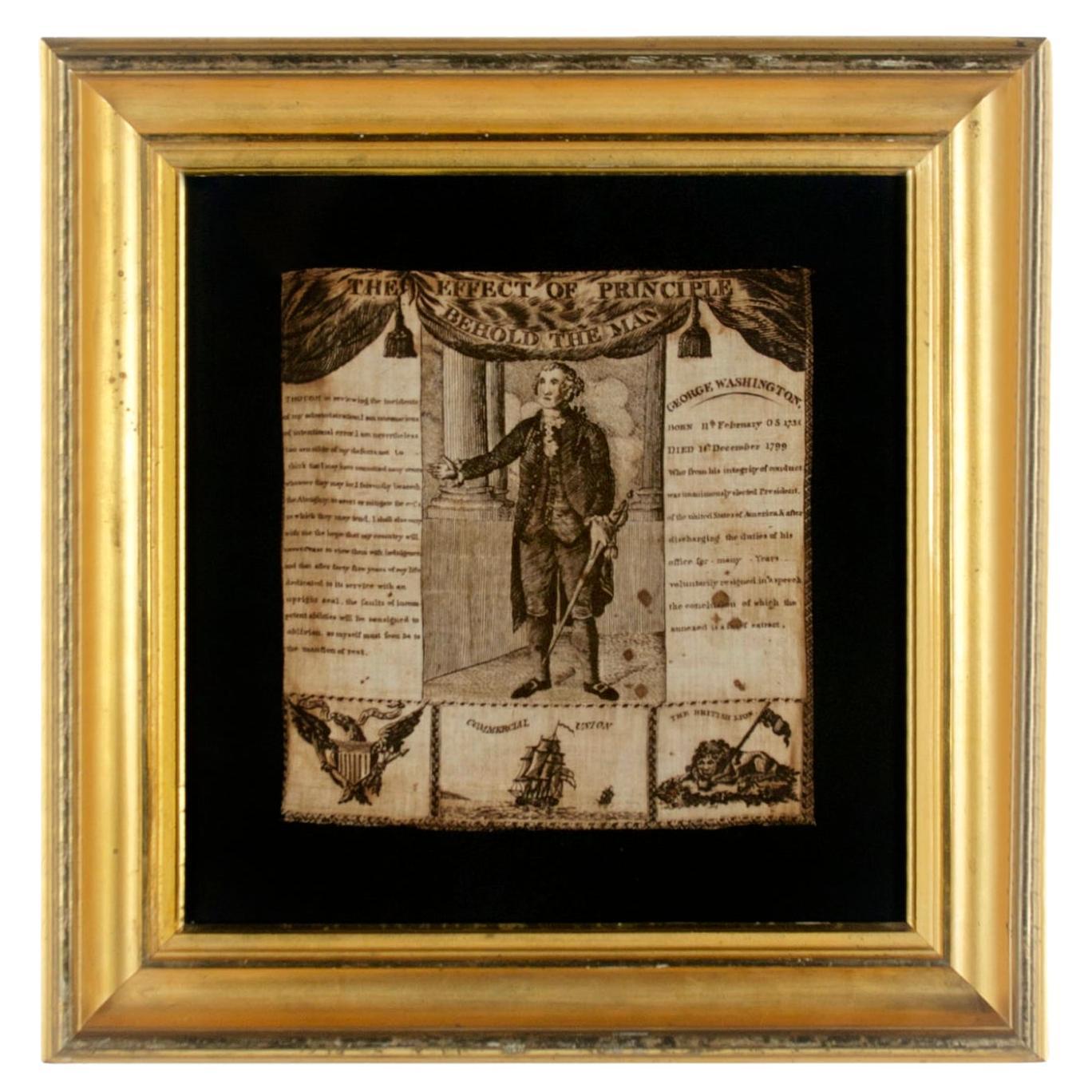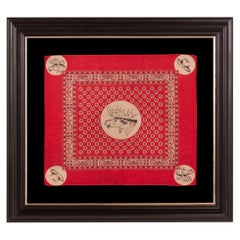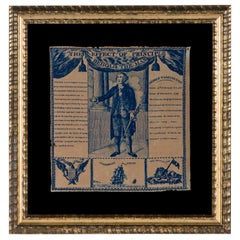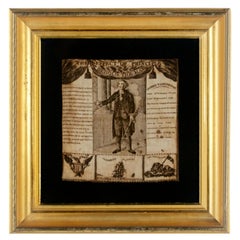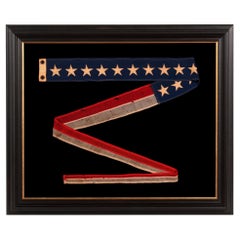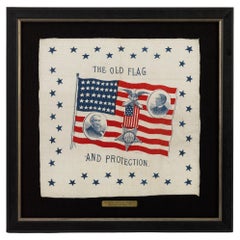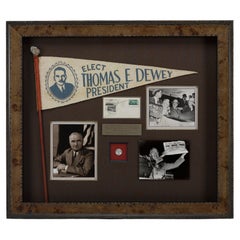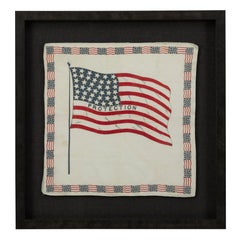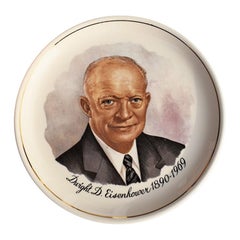Items Similar to Eisenhower's 1952 Portrait Style Presidential Campaign Kerchief
Want more images or videos?
Request additional images or videos from the seller
1 of 6
Eisenhower's 1952 Portrait Style Presidential Campaign Kerchief
$1,950
£1,490.88
€1,717.19
CA$2,732.55
A$3,050.63
CHF 1,598.49
MX$37,342.74
NOK 20,300.78
SEK 19,141.06
DKK 12,815.57
Shipping
Retrieving quote...The 1stDibs Promise:
Authenticity Guarantee,
Money-Back Guarantee,
24-Hour Cancellation
About the Item
PORTRAIT STYLE KERCHIEF FROM THE 1952 PRESIDENTIAL CAMPAIGN OF REPUBLICAN IKE EISENHOWER, FORMER SUPREME COMMANDER OF ALLIED FORCES IN EUROPE DURING WWII (NATO)
Printed cotton kerchief, made for the 1952 presidential campaign of General Dwight David "Ike" Eisenhower and Richard M. Nixon. A portrait of the man who would become the 34th President of the United States appears above his famous slogan, "I Like Ike", within a flag-draped, oval frame, decorated with scrollwork and crowned with a star. Above this, in large lettering, the following text appears: "Win With Ike For President."
The turkey red background has a white calico print in the center, surrounded by a swag border of red and blue stripes. "Ike" appears below the gathering of each valence and a patriotic shield anchors each corner. A maker's mark appears along the edge, and though it does not reveal the maker's name, the words "Fast Color" surround an image of an elephant, the Republican Party mascot.
A Brief History of Dwight D. "Ike" Eisenhower:
A U.S Army general, Eisenhower served as Supreme Commander of the Allied forces in Europe during WWII. He was immensely popular and produced landslide wins in both 1952 and 1956, losing only in the Democratic, deep South to his opponent, Adlai Ewing Stevenson II, Governor of Illinois. Stevenson's grandfather, Adlai Ewing Stevenson I, served as Vice President under Grover Cleveland following his second campaign win (1892), made an unsuccessful bid for the 1896 presidential nomination, then ran again on the 1900 ticket for Vice President under William Jennings Bryan in 1900, in a campaign lost to William McKinley & Teddy Roosevelt.
Born on October 14th, 1890, in Denison, Texas, Eisenhower grew up in Abilene, Kansas, where he "absorbed the virtues of small town America that distinguished him the rest of his life-scrupulous honesty, self-reliance, determination, and hard work as President" (U.S. Army Center of Military History, publication 71-40). Graduating from West Point in 1915, Eisenhower served as Captain during WWI (U.S. involvement 1917-18), but never left the States, which immensely disappointed him. During the signing of the Armistice of November 11th, 1918, that ended the war, he was in command of Camp Colt, the Army's tank corps training center on the Civil War battlefield at Gettysburg. In 1930, he became special assistant to General Douglas MacArthur, then Chief of Staff, which vaulted him up the Army food chain.
Eisenhower followed McArthur to the Philippines, but after the bombing of Pearl harbor, he was summoned to Washington to serve under Franklin Roosevelt's U.S. Army Chief of Staff, General George C. Marshall, who would oversee the building of the largest military force in U.S. history. Marshall appointed Eisenhower chief of the War Plans Division (subsequently Operations Division), the office widely regarded as the brains of the Army. After the German surrender, Eisenhower, now Chief of Staff, presided over the postwar demobilization. During this time he became the Army's first Chief of Staff to participate in the newly created, unified, Joint Chiefs of Staff.
In 1948, Eisenhower retired from the Army to become president of Columbia University, but the Korean War followed shortly thereafter and, in 1951, he became the first supreme commander of Allied Forces in Europe (NATO). Eisenhower would eventually end the war as president and he maintained a stern eye on the Cold War during his tenure in the Whitehouse. He was the first president to be "constitutionally forced" from office, in 1961, having served the maximum two terms. Term limitations had come about via the 22nd Amendment to the U.S. Constitution, ratified in 1951, just prior to Eisenhower’s 1952 election. Following the presidency he retired to Gettysburg. He passed in 1969 at Walter Reed Hospital and was buried in his hometown of Abilene, Kansas. His funeral was presided over by then-president Richard Nixon, who had served as Eisenhower's vice president for both terms.
Mounting: The textile was mounted and framed within our own conservation department, which is led by expert trained staff. We take great care in the mounting and preservation of flags and have framed thousands of examples.
The mount was then placed in a black-painted, hand-gilded and distressed Italian molding. Spacers keep the textile away from the glass, which is U.V. protective. Fell free to contact us for more details.
Condition: Minor fading.
- Dimensions:Height: 46 in (116.84 cm)Width: 46 in (116.84 cm)Depth: 25 in (63.5 cm)
- Materials and Techniques:
- Place of Origin:
- Period:
- Date of Manufacture:1952
- Condition:See Item Description.
- Seller Location:York County, PA
- Reference Number:Seller: ker-0011stDibs: LU849740262472
About the Seller
5.0
Recognized Seller
These prestigious sellers are industry leaders and represent the highest echelon for item quality and design.
Established in 1991
1stDibs seller since 2008
70 sales on 1stDibs
Typical response time: 1 to 2 days
- ShippingRetrieving quote...Shipping from: York County, PA
- Return Policy
Authenticity Guarantee
In the unlikely event there’s an issue with an item’s authenticity, contact us within 1 year for a full refund. DetailsMoney-Back Guarantee
If your item is not as described, is damaged in transit, or does not arrive, contact us within 7 days for a full refund. Details24-Hour Cancellation
You have a 24-hour grace period in which to reconsider your purchase, with no questions asked.Vetted Professional Sellers
Our world-class sellers must adhere to strict standards for service and quality, maintaining the integrity of our listings.Price-Match Guarantee
If you find that a seller listed the same item for a lower price elsewhere, we’ll match it.Trusted Global Delivery
Our best-in-class carrier network provides specialized shipping options worldwide, including custom delivery.More From This Seller
View AllTeddy Roosevelt Silk Kerchief Made for His 1912 Presidential Run
Located in York County, PA
SILK CAMPAIGN KERCHIEF FEATURING A PROMINENT BULL MOOSE, MADE FOR THE 1912 PRESIDENTIAL RUN OF TEDDY ROOSEVELT, WHEN HE RAN ON THE NATIONAL PROGRESSIVE PARTY TICKET
Printed silk ker...
Category
Vintage 1910s American Political and Patriotic Memorabilia
Materials
Silk
Price Upon Request
1806 Printed Linen Kerchief Glorifying George Washington, Germantown, Penn
Located in York County, PA
EXTRAORDINARILY EARLY (1806) PRINTED LINEN KERCHIEF GLORIFYING GEORGE WASHINGTON, PRINT WORKS, GERMANTOWN, PENNSYLVANIA
Printed in blue ink on coarse, white linen, this patriotic kerchief shows a standing portrait of George Washington, above which is a swag valance and the words “The Effect of Principle, Behold the Man”. The portrait is based on a mezzotint after Gilbert Stuart’s very famous painting of Washington in his later years, most often referred to as the Landsdowne portrait. Stuart painted three versions of it in oil on canvas, one of which was completed in 1796 for a wealthy merchant by the name of William Constable, who commissioned the work for Alexander Hamilton.
The kerchief is interesting because it is both American-made and documented. This is exceptionally unusual for any printed textile of the 19th century or prior and the earlier the time period the more unlikely an object is to be identified. This kerchief and a companion piece entitled “The Love of Truth Mark the Boy” (also glorifying Washington, through the fabled story of the cherry tree), were made circa 1806 by Germantown Print Works in Germantown, Pennsylvania.
To the left of Washington's image is a portion of his infamous farewell address to his troops at the end of the Revolutionary War. To the right is a short excerpt from his eulogy. Below these are three images. In the center is a square-rigged tall ship with “Commercial Union” above it, flanked by the American eagle on the left and the British lion on the right. It is reasonable to assume that the textile may have been produced in demonstration of the maker's desire, and/or that of others, to advance trade with England. Commercial printers were very influential in early America, as they possessed the means by which to disseminate information.
This kerchief and its companion piece are documented in Threads of History, Americana Recorded on Cloth, 1775 - the Present, by Herbert Ridgeway Collins (1979, Smithsonian Press), p. 63, items 38 & 39.* The two pieces pictured are in the collection of Cornell University, but the Collins text also cites an uncut pair to be present in the collection of the Western Reserve Historical Society, Cleveland, OH. The name "Germantown Print Works" is printed on the Western Reserve examples. Another example of the textile in question is documented in "Running for President, The Candidates and Their Images, 1789-1896" by Schlesinger, Israel, and Frendt, (1994, Simon & Schuster), p. 15.
I have seen three different color variations of this textile, including sepia, mulberry red, and blue. This particular example has a hand-sewn binding along the top, lower, and left edges.
Mounting: The textile was mounted and framed within our own conservation department, which is led by expert staff. We take great care in the mounting and preservation of flags and have framed thousands of examples.
The gilded molding has a rippled profile and dates to the period between 1825 and 1850.The background is 100% cotton twill, black in color. The glazing is U.V. protective plexiglass. Feel free to contact us for more details.
Condition: There is an all-over golden oxidation of the white fabric and there is very minor staining. There are tiny tack holes in each corner and there are minor nicks around the perimeter.
* Collins relates that Germantown Printworks was operated by the Hewsons. In doing so he cites one of Worthington Chauncey Ford's books on George Washington, but it isn't clear which one (there are many) and no page numbers are given. John Hewson was an Englishman who came to America and opened his printing business on the advice of Benjamin Franklin. He was one of the first “calico printers” and is the earliest documented to have advertised printed kerchiefs. His ads for bandanas appear as early as June 20th, 1774. He is suspected of having produced the very first American kerchief that pictured an American president, which is documented in Collins as item 1 on page 48. Linda Eaton, curator at Winterthur, in 2012, is currently doing in depth research on the three printers of fabrics that were operating in Germantown in early America. She discovered that the owner and/or operator of Germantown Print Works, while not currently known, was not John Hewson. This information is not yet published. She also noted that Winterthur possessed examples of the two George Washington textiles...
Category
Antique Early 1800s American Political and Patriotic Memorabilia
Materials
Cotton
Printed Linen Kerchief of George Washington, ca 1806, Germantown, PA
Located in York County, PA
Extraordinarily early (1806) printed linen kerchief glorifying George Washington, Germantown print works, Germantown, Pennsylvania
Printed in sepia ink on coarse, white linen, this patriotic kerchief shows a standing portrait of George Washington, above which is a swag valance and the words “The Effect of Principle, Behold the Man”. The portrait is based on a mezzotint after Gilbert Stuart’s very famous painting of Washington in his later years. Stuart painted it in oil on canvas for a wealthy merchant by the name of William Constable, who commissioned the work for Alexander Hamilton.
The kerchief is interesting because it is both American-made and documented. This is exceptionally unusual for any printed textile of the 19th century or prior and the earlier the time period the more unlikely an object is to be identified. This kerchief and a companion piece entitled “The Love of Truth Mark the Boy” (also glorifying Washington through the fabled story of the cherry tree), were made ca 1806 by Germantown Print Works in Germantown, Pennsylvania.
To the left of Washington's image is a portion of his infamous farewell address to his troops at the end of the Revolutionary War. To the right is a short excerpt from his eulogy. Below these are three images. In the center is a square-rigged tall ship with “Commercial Union” above it, flanked by the American eagle on the left and the British lion...
Category
Antique Early 19th Century American Political and Patriotic Memorabilia
Materials
Linen
Commission Pennant with 13 Stars, like for Private Vessel, Ca 1892-1910
Located in York County, PA
Commission pennants are the distinguishing mark of a commissioned U.S. Navy ship. Flown at the topmast, the typical American format is a long blue field, usually with a single row of white stars, although sometimes with their total divided into two rows, followed by two long stripes, red-over-white. A ship became commissioned when this pennant was hoisted. Flown during both times of peace and war, the only time the pennant is not flown is if a flag officer or civilian official was aboard and replaced it with their own flag.
Sometimes the owners of private ships mimicked the use of Navy signals. Some seafaring men would have served in the Navy and become privy to various practices in that capacity. Others flew them purely for stylistic reasons, either on a regular basis or while the boat was dressed for special occasion. Hudson River steamers regularly flew pennants of this nature, as evidenced by period photography as well as the paintings of artists such as John and James Bard...
Category
Antique Late 19th Century American Political and Patriotic Memorabilia
Materials
Wool
Price Upon Request
13 Star Commission Pennant, 6 Foot in Length, ca 1892-1910
Located in York County, PA
6-FOOT SHIP’S COMMISSION PENNANT WITH A 5.5” HOIST AND 13 STARS IN 2 STAGGERED ROWS, LIKELY PRODUCED FOR A PRIVATE VESSEL, circa 1892-1910
Commission pennants are the distinguishing...
Category
Antique 1890s American Political and Patriotic Memorabilia
Materials
Wool
Hand-Painted 19th Century Banner with the 1867 Proposed Seal of Illinois
Located in York County, PA
HAND-PAINTED 19TH CENTURY BANNER WITH AN 1867 VERSION OF THE SEAL OF THE STATE OF ILLINOIS, PROPOSED IN THAT YEAR BY THE SECRETARY OF STATE, BUT IN A VARIATION NEVER FORMALLY ADOPTED
Banner with the Illinois State Seal, in a rare variation of the design, never adopted. In 1867 Illinois Secretary of State Sharon Tyndale proposed that the phrases in the state motto be reversed. In the wake of the Civil War, (which ended in 1865,) Tyndale suggested that the verbiage be changed from "State Sovereignty--National Union" to "National Union--State Sovereignty,” which made sense given the recent secession of the Southern States, which placed their own interests first. Illinois' own Abraham Lincoln had worked hard to preserve national interests, echoed here in the altering of the language. Though Tyndale’s suggestion was rejected, he was nonetheless charged with creating a new design, which he did and was soon adopted. This displayed the dates of "1818," when Illinois became a state, and "1868," when the seal was officially changed. Interestingly enough, Tyndale did manage to send a message in the new version by turning the word “sovereignty” upside-down , with the surmised explanation that this fit accordingly with the orientation / position of the streamer.
The banner is beautifully hand-painted on muslin and retains its original staff. The shape is beautifully scalloped at the bottom edge, which is painted to look as if there is an applied fringe. Most of the elements are congruent with the 1868 version, but there are various differences. Set within a shield-shaped medallion—usually circular—is the expected eagle in a side view, spread wing pose with beak uplifted. The eagle is supposed to be perched upon a rock with one talon, while gripping a Federal shield in the other. Here there is no rock and both talons grip the shield, which displays 13 stars. Note the date of "1867" and Tyndale's preferred order of the wording on the billowing ribbon in the eagle's beak. The foreground of the official design is all grass. Here there are olive branches—a peacetime reference appropriate for a country recovering from war—on a grassy area, set upon a sandy shore before Lake Michigan, with a rising sun on the horizon.
Mounting: The banner was mounted and framed within our own conservation department, which is led by masters degree trained staff. We take great care in the mounting and presentation of flags and have preserved thousands of examples; more than anyone worldwide.
The background is 100% cotton twill, black in color. The mount was placed in a black-painted, hand-gilded and distressed Italian molding. A shadowbox was created to accommodate the staff. The glazing is U.V. protective plexiglass. Feel free to contact us for more details.
Banner - 49" x 56.5"
Frame - 67.75" x 59.25"
About Jeff R. Bridgman Antiques, Inc.:
As an advisor to top museums and collectors alike, Jeff Bridgman is the world's leading expert and source for antique American flags and political textiles...
Category
Antique 1860s American Political and Patriotic Memorabilia
Materials
Cotton
Price Upon Request
You May Also Like
"The Old Flag and Protection" Benjamin Harrison Campaign Handkerchief, 1888
Located in Colorado Springs, CO
Presented is an original Benjamin Harrison campaign handkerchief, from the 1888 presidential election. Printed on white silk, this design features a waving 39-star American flag and ...
Category
Antique 1880s American Political and Patriotic Memorabilia
Materials
Silk
Thomas Dewey & Harry Truman 1948 Presidential Election Campaign Collage
Located in Colorado Springs, CO
Presented is a unique commemorative collage, celebrating the 1948 U.S. presidential election between Harry Truman and Thomas Dewey. This one-of-a-kind collage features a Harry Truman signed...
Category
Vintage 1940s American Mid-Century Modern Political and Patriotic Memora...
Materials
Metal
39-Star "Protection" Benjamin Harrison Political Kerchief
Located in Colorado Springs, CO
Presented is a printed linen political kerchief for Benjamin Harrison, from his 1888 Presidential campaign. The kerchief features a waving 39-star American flag at the center of a wh...
Category
Antique 1880s American Political and Patriotic Memorabilia
Materials
Linen
President Dwight D. Eisenhower Commemorative Ceramic Plate
Located in Oklahoma City, OK
A round ceramic commemorative plate of President Dwight Eisenhower. The plate is circular, with gold detail around the edges, and a portrait of Presi...
Category
20th Century North American American Classical Historical Memorabilia
Materials
Gold
$160 Sale Price
20% Off
1960 "Kennedy for President. Johnson for Vice President" Vintage Campaign Poster
Located in Colorado Springs, CO
This is an original 1960 campaign poster for Democratic-nominees John F. Kennedy and Lyndon B. Johnson, elected as our 35th President and 37th Vice President. This poster was an inte...
Category
Vintage 1960s American Mid-Century Modern Posters
Materials
Paper
Large Framed American Flag Folk Art Quilt
Located in Santa Monica, CA
Nicely faded American flag quilt. Excellent hand stitched dancing Folk Art stars. Skilled quilting, a nice graphic large-scale wall hanging. White ...
Category
Early 20th Century North American Folk Art Political and Patriotic Memor...
Materials
Cotton
More Ways To Browse
Vintage American Memorabilia
Folk Art Texas
Portrait In Oval Frame
William Shields
Small American Flag
Space Memorabilia
Mark Marshall
Italy Flag Vintage
Korean Folk Art
Star Wars Prints
WWII Flags
Blue Star Flag
German Texas
Vintage Political Memorabilia
Train Memorabilia
Wwi German
Civil War Memorabillia
Civil War Flags
